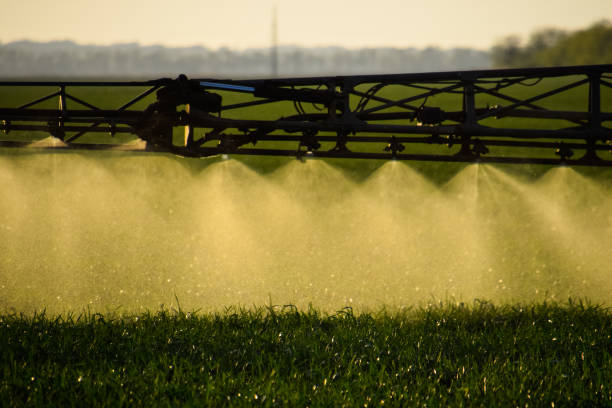Alachlor

Parameter Type: Drinking Water Testing for Semi-Volatile Organics
Parameter Name: Alachlor
What it is and Where it Comes From:
Alachlor is a herbicide from the chloroacetanilide family. It is an odorless, white solid. The greatest use of alachlor is for control of annual grasses and broadleaf weeds in crops. Use of alachlor is illegal in the European Union and no products containing alachlor are currently registered in the United States. The largest use of alachlor is as a herbicide for control of annual grasses and broadleaf weeds in crops, primarily on corn, sorghum, and soybeans. Alachlor mainly enter the environment through application to farm fields. This herbicide also can get into the environment if it is improperly stored or mixed before application. Groundwater contamination may occur when alachlor or atrazine moves from an application or spill on soil into a shallow aquifer. Improperly constructed wells have a high risk of contamination. Exposure to alachlor in groundwater occurs mainly by drinking contaminated water. You also may be exposed to small amounts through your skin while bathing or showering in contaminated water. Pets and other animals should not drink water with alachlor levels above 0.002 ppm. Drinking water testing gives you several benefits like peace of mind, identifying contaminants in your water, and insight into health concerns. Safe Home offers Laboratory drinking water testing kits for alachlor, allowing you to collect your water sample and ship it directly to our EPA-Certified Laboratory. This platform of drinking water testing for alachlor will give you an accurate level based on the lowest level of a parameter our instruments can detect (Method Detection Level). Safe Home drinking water testing for semi-volatiles can be used for city and well water supplies. Drinking water testing should be done any time you notice a significant change in your water quality.
Health Effects:
Drinking water containing alachlor over long periods of time may damage the liver, kidneys, eyes, and spleen. Alachlor is thought to be a possible cancer-causing substance, but There is no evidence that this herbicide causes cancer in humans, but it has been linked to tumors in mice and rats. Alternatives to treatment include developing a different water source or connecting to another safe water source in the area. Alachlor contamination can be prevented by avoiding source water that contains agricultural runoff. Treatment has limitations and disadvantages
Solutions to Contaminant Levels:
After drinking water testing, how can I resolve the issue? There is no evidence that boiling removes alachlor. Alachlor can be reduced below 2 ppb in drinking water using granular activated carbon filtration. Not all kinds of treatment are effective, and no single treatment method can remove all contaminants from water. Treatment options are available to remove alachlor from well water. The most used is called granular activated carbon filtration. Options include central treatment (at the well or entry to home) or a point-of-use device (kitchen sink filter). Carbon filtering is a method of filtering that uses a bed of activated carbon to remove impurities from a fluid using adsorption. However, these filter systems must be serviced regularly to work properly. If your well is contaminated, using quality bottled water for drinking purposes will greatly reduce your exposure to these herbicides. Who do I need to contact to find out more information about water quality in my area? Every community water supplier must provide an annual report to its customers, known as a Consumer Confidence Report (CCR). The report provides information on your local drinking water quality, including the water’s source, contaminants found in the water, and how consumers can get involved in protecting drinking water. How often does the local public water system preform drinking water testing? Frequency of drinking water testing depends on the number of people served, the type of water source, and types of contaminants. Certain contaminants are tested more frequently than others, as established by the Safe Drinking Water Act. You can find out about levels of regulated contaminants in your treated water for the previous calendar year in your annual Consumer Confidence Report (CCR).
File Under: Semi-Volatile Organics
Drinking Water Testing - Parameter Types
Important Terms
-
MCL’s (Maximum Contaminant Levels) MCL’s are levels that set by the USEPA and are enforceable to Public Water Utilities, requiring additional treatment, when the levels are exceeded. These same guidelines should be at least considered, by owners of private wells. Some states have more strict guidelines than the USEPA. Not all parameters have MCL’s. If the parameter has an MCL, it’s listed.
-
MCLG’s (Maximum Contaminant Level Goals) MCLG’s are goals set by the USEPA that we should all strive for when consuming drinking water from any water supply. Concentrations of certain parameters (even below the MCL’s), are still not healthy for humans and animals to drink. These same guidelines should at least be be considered, by owners of private wells. Some states have more strict guidelines than the USEPA. Not all parameters have MCLG’s. If the parameter has an MCLG, it’s listed.
-
ACTION LEVELS ACTION LEVELS are a specified concentration of a respective parameter in drinking water, that is above a “treatment level” set by the USEPA. When these levels are exceeded, further treatment and monitoring is required by the respective utility who’s water violated this limit.Action Levels apply to parameter-rules such as but not limited to the Copper/Lead Rule.
-
PARTS PER MILLION (ppm) PPM is a scientific measurement which represents milligrams of the parameter being tested per liter of the respective liquid. Example: If Copper in your water supply is at a concentration of 1.00 mg/L, this is the same as saying the concentration is 1.00 ppm.


